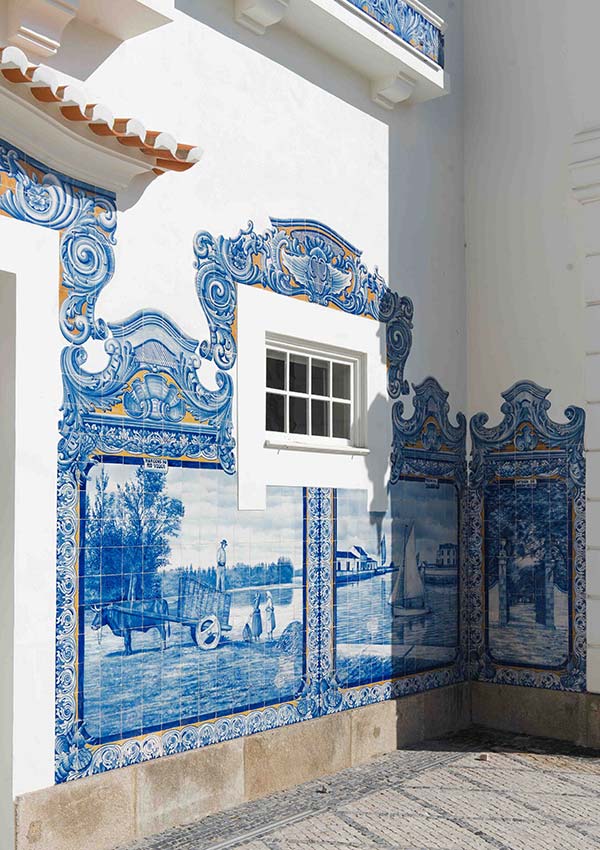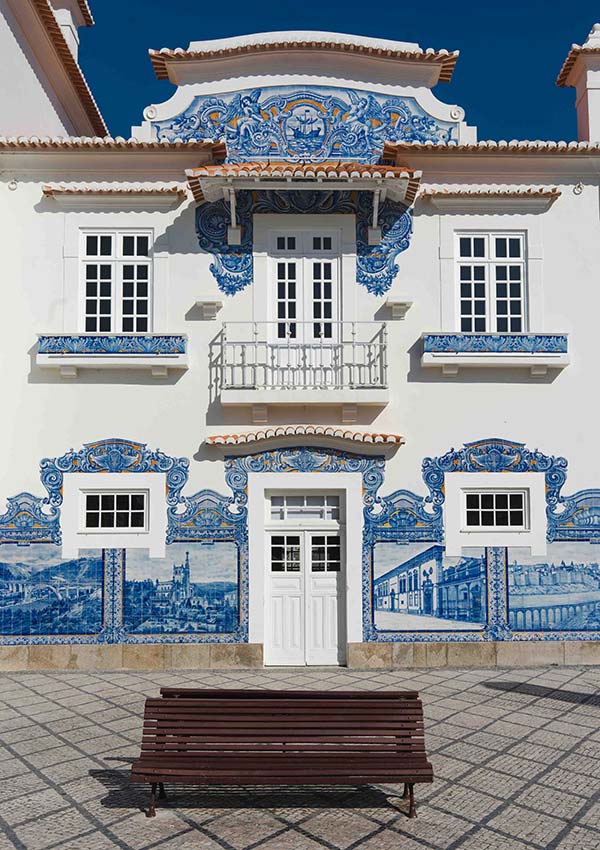One of my favourite things about Portugal’s many tiled train stations is that they double as a tourism brochure. If you arrive in Aveiro by train, take the time to lap the original Aveiro Train Station building where 50 blue, yellow and white tiled panels detail the history of the city, its culture, people and famous landmarks.
But when these tiles were unveiled back in 1916 they became a subject of great controversy in local newspapers, and even lead to a court case. Let’s dive into why…

Contents
ToggleThe history of Aveiro Train Station’s tiles
The Estação Ferroviária Aveiro originally opened on April 10, 1864 with a small and modest building. Apparently, due to the marshy nature of the land, the embankments sank several times during construction and kept having to be rebuilt.
Aveiro quickly outgrew its small station, and the beautiful tiled white building we see today was built in 1916, designed by architect José Coelho in a traditional Portuguese style.
Adding tiled panels to train stations was in fashion at the time, and so 50 remarkable blue, yellow and white tile panels were created in the Fonte Nova Factory by artists Francisco Pereira and Licínio Pinto.


The tiled panels feature local figures, famous monuments and natural landscapes that you can see in the Aveiro region. Some of the tile panels feature people dressed for traditional trades; landscapes of traditional agricultural activities; and distinguished locals who contributed to the railway’s construction.
Look closely at the tiles and you’ll see illustrations of the Aveiro salt marshes, Costa Nova, Vouga River, fishermen’s boats, the Bussaco Hotel, Monastery of Alcobaça, Almourol Castle, Barra Lighthouse, and many more.
Read next: 11 best things to do and see in Aveiro




The azulejo controversy of Estação Ferroviária Aveiro
When the plans to link Porto and Lisbon by railway were being conceived Aveiro was not on the route. Apparently it was at the insistence of notable Portuguese journalist, politician and parliamentary speaker, José Estevão, who was originally from the city and held the position of chamber deputy at the time. He convinced the government to study and change the route to include Aveiro.
When unveiled in 1916 the tile panels caused plenty of debate in the local papers, and even lead to a court case. But why?




So allegedly the Portuguese train company (Companhia Real dos Caminhos de Ferro Portugueses) was planning to add two figures – José Estevão and Manuel Firmino – side-by-side immortalised in tiles. Both were involved with the construction of the train station, but after major controversies between Manuel Firmino’s family and José Estevão’s supporters, only Manuel Firmino’s panel was confirmed.

A resolution more than 100 years late?
The station was remodelled in 1986, and on the station’s 75th anniversary a new tile panel by Breda was added, created at the Viçorzette Factory in Águeda.
In 2000, two more tile panels were added to the bathrooms, created by F. Lista at the Artecer Factory in Vila Nova de Gaia.
But it wasn’t until April 2018, some 102 years later, that a new tile panel by artist Marcos Muge was added In honour of 19th-century deputy José Estêvão.
In 2021 the building was rehabilitated and it now acts as the “Porta da Cidade” or City Welcome Gate. Inside you can find local salt, traditional ovos moles sweets, and wines from Bairrada.
Read next: How to spend 48 hours in Porto




How to see all the tiles at Aveiro Train Station
A shiny new passenger terminal was built next door to the original in 2005, so to view all of the azulejos in their glory you’ll need to shuffle along one of the platforms and then exit through the new terminal to reach the outer side of the 1916 tiled building.



Other amazing tiled train stations in Portugal
Portugal has no shortage of spectacular tiled train stations. If you liked this one, check out the grand entrance hall of Porto’s São Bento Train Station. With 20,000 tiles lining the hall it’s definitely the most magnificent in the country.
Another one that’s worth a visit the beautiful Santarém Train Station, which features similar tiled panels that show scenic highlights and tourism attractions in the area.
Want more #tileoftheday posts? I got you.














2 Responses
Thank you for the article. I passed by the train station yesterday and was a little puzzled why they have restored the station the way they have, without actually using it. But it certainly looks nice. Just like all the other older train stations scattered around Portugal.
Hi Claus, I know! I agree. Aveiro is actually very busy and having been there at rush hour a number of times, a lot of people use the station so I guess the older building isn’t enough. It’s a shame it’s not more incorporated into Platform 1 though!